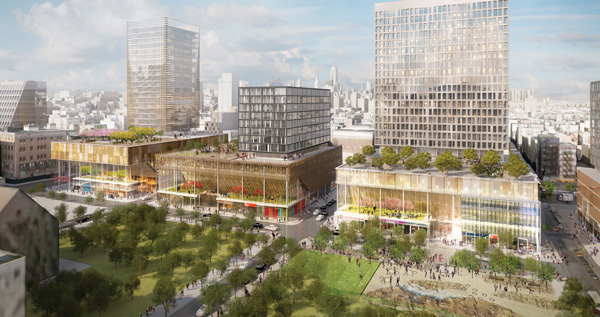
BY HEATHER DUBIN | After nearly 50 years of inertia at the Seward Park Urban Renewal Area, on Wednesday Mayor Bloomberg announced that developers have been selected for a $1.1 billion plan for the site’s nine remaining city-owned lots at the foot of the Williamsburg Bridge.
The selected developers are L+M Development Partners, BFC Partners and Taconic Investment Partners.
Bloomberg and city officials revealed the project’s full scope at a press conference held inside a derelict former public market building on Essex St., part of the SPURA project site.
The nine vacant lots will be transformed into a mixed-use complex of commercial space and 1,000 residential apartments. Half the residential units will be permanent affordable housing for low-, moderate- and middle-income families and senior citizens. The other half will be market rate.
Some highlights of the 1.65-million-square-foot development, to be called Essex Crossing, include an Andy Warhol Museum, an expanded Essex Street Market, office space, a dual-generational school run by The Educational Alliance, a rooftop urban farm, a movie theater and a bowling alley.
Designed by SHoP Architects and Beyer Blinder Belle, the project is anticipated to break ground in spring 2015 for five buildings. Essex Crossing will also be home to a future potential school, along with a hub for entrepreneurs and the technology sector.
Former SPURA residents were required by the city to vacate their tenement homes in 1967. The site was razed, and affordable housing was supposed to be built. Instead, nothing happened — except for years of arguments between community members and politicians — and the lots stood still.
Former SPURA residents will receive top priority when applications are processed for apartments, and can seize the opportunity to return to the neighborhood decades later if they so desire.
“In 1967, the site was demolished by government with promises of revitalization. What happened was only neglect,” Bloomberg said. “That promise of 1967 is now going to be fulfilled.”
The mayor said the SPURA site represents the largest parcel of underdeveloped land in Manhattan south of 96th St.
Essex Crossing will create 1,600 new jobs and 4,400 construction jobs, with language in its contract that requires use of union labor.
Bloomberg also pointed out the space is designed for small businesses, adult education classes and a community space run by the Grand Street Settlement.
“It’s a changing point of New York for the good, it really does have the support of everyone,” Bloomberg said. He complimented the community’s key role in the development process, and attributed it to the project’s success.
Half of the affordable housing is scheduled for completion three years after ground is broken on the mega-project.
Two more buildings should be constructed by 2021, with the entire project finished by 2024.
“If anyone is opposed, raise your hand or forever hold your peace,” Bloomberg joked. “I’ve heard that before.”
Ron Moelis, C.E.O. of L+M Development Partners, said it was a life goal of his to do this type of community work, and hopes Essex Crossing will serve as a model in other communities. He pointed out the area’s mix of populations, ethnicities and income.
Kyle Kimball, president of the city’s Economic Development Corporation, said the project — notably, its small office spaces — would improve on the neighborhood’s historic strengths.
“The 250-square-foot office spaces for creativity and technology will nurture the next generation of entrepreneurs on the Lower East Side,” he said. Smaller spaces will also help to keep the commercial use more affordable.
Charles Bendit, co-C.E.O. of Teconic Investment Partners, spoke about the Lower East Side as the place where his grandparents settled when they came to the United States.
“Essex Crossing will be home to the new Essex Market,” he said. “Many New Yorkers can trace their roots back to this neighborhood — and it’s designed to offer the same [kind of] entrepreneurial space.
“Essex Crossing will transform New York City into an incubator for economic growth,” Bendit added.
Bloomberg applauded City Councilmember Margaret Chin for helping shape Essex Crossing.
“This is such a historic day,” Chin said. “People put aside their differences,” she added, referring to how a divided community was finally able to reach consensus on guidelines for the plan.
The councilmember mentioned that people were critical of her for not securing 100 percent affordable housing at SPURA, but she acknowledged that 50 percent affordable housing was pretty good.
Chin also put in a plug for the new school with the mayor, and asked for his assistance securing the site, which is currently reserved and under consideration by the Department of Education.
When asked by a reporter if Essex Crossing could be reversed by the next mayor, Bloomberg dismissed the notion.
“We’ve signed contracts,” he said. “It’s a done deal.”
Another reporter questioned Bloomberg’s “legacy” on development, and wondered if Essex Crossing was the last significant project in his final term.
“I have 140 days left,” Bloomberg said, implying he still had more work left to be done — and possibly more projects underway.
In terms of making his mark, Bloomberg denied it’s something he’s focused on.
“I’ve never thought much about ‘legacy,’ ” he said. “I’m not sure what it means.”

















